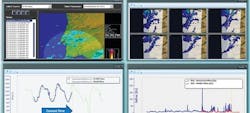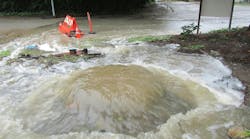About the author: Pedro Pina is a water industry solution architect–EMEA for Bentley Systems. Pina can be reached at [email protected]. The author thanks SimTejo and Hidromod for their help and assistance in producing this article.
Lisbon, Portugal’s sewerage network, which is managed by Saneamento Integrado dos Municípios do Tejo e Trancão (SimTejo), comprises separate sanitary sewers and combined wastewater systems as well as partially separate systems. Lisbon experiences short, intense periods of heavy rainfall that often lead to flash floods, which, when combined with high tides, often cause the network to fail.
SimTejo had access to large amounts of infrastructure and operational data from its water network, including SCADA data, sampling data and data from quality probes, as well as from other sources such as hydraulic model results from SewerGEMS. However, SimTejo realized it needed to consolidate and integrate this data into useful, actionable information. To provide real-time data for operations and modeling emergency and planning scenarios, SimTejo chose Bentley developer partner Hidromod to help create a tool that enabled the management of drainage and wastewater treatment.
Improving Operational Management
SimTejo already was using modeling tools such as Bentley's SewerGEMS for planning activities, but wanted a way to use these tools to enable real-time forecasting of potential overflows, uncontrolled discharges and flows into the wastewater treatment plant. To increase efficiency and improve planning, SimTejo also needed to provide non-specialist staff with clear, simple reporting that could be customized according to the user’s respective needs and skills.
SimTejo worked with Hidromod to create Aquasafe based on SimTejo’s requirements. The system provides SimTejo with integrated models and real-time data, enabling proactive management, including forecasting and short-term planning, while simplifying the presentation of results for non-specialist and operations staff.
Aquasafe automates the execution of SewerGEMS—a sewer analysis system (including the catchment area) used for offline studies to improve operations and energy efficiency on the pumping system—and connects it to real-time data and weather forecasts. The sewer analysis system was integrated with Bentley’s WaterObjects.Net customization technology.
Real-Time Data
The sewer model automatically runs every 15 minutes with updated measured rainfall and rainfall forecasts from an operational meteorological forecast model. Using this information, SewerGEMS can provide a 24-hour forecast of flows, velocity, water levels and pump behavior in the drainage network, land overflow and incoming flows to the wastewater treatment plant.
Aquasafe also automates data connections from rain gauges, flowmeters, pumping stations and more, providing real-time integrated data that would have been virtually impossible to obtain without the addition of numerous engineers and specialists. The system enabled SimTejo to provide its operators with the hydraulic and wastewater treatment models that typically are used by engineers, enabling the models to be integrated into day-to-day operations and used for decision making. Ultimately, Aquasafe will help SimTejo personnel prevent, detect and respond to a wide range of situations, including normal operation, emergencies and customer complaints.
Observed Improvements
Implementing the new system reduced pumping station failure by more than 60%, saving €100,000 in annual maintenance costs and €30,000 in penalties per year. Improving the efficiency of 90 pumping stations is expected to earn a 2% reduction in energy consumption. Given that the cost of energy for pumping was close to €8 million in 2011, this represents an annual savings of approximately €160,000. SimTejo anticipates a further €180,000 in annual energy savings related to the wastewater treatment plant.
Pedro Povoa, R&D project manager for SimTejo, said, “This system has been online since February 2011. Further savings were achieved from improved operations and maintenance, which reduced the number of man-hours required for maintenance processes and the need for specialized engineers to run models and integrate data from different sources. This resulted in an annual savings of €120,000 in specialized engineers and consulting, as well as €200,000 in integrating models and databases.”
Mitigating Impact
The coastal areas adjacent to the Tagus estuary contain many popular beaches frequented by tourists in the summer months. In the past decade, there has been a great effort to identify and eradicate contamination sources in area watersheds. The new system is part of the strategy to provide decision makers with the necessary information in real time so they can take appropriate actions in emergency situations regarding unavoidable discharges to the estuary.
“It now takes no more than 15 minutes to detect and alert abnormal behaviors on flowmeters by comparing measured flow with modeled flows, as well as just five seconds to produce accurate combined sewer overflow and estuary discharge reports for environmental authorities,” Povoa said. “Preventing infrastructure collapse and flooding increased public safety and helped protect Lisbon’s waterways from pollutants.”
Download: Here


